SCHOLTES TI 6514, TI 6514 400, TI 6523, TI 7624, TI 7624 400 User Manual
...
Istruzioni per l’uso
PIANO COTTURA
|
|
|
|
|
|
|
|
|
|
|
|
|
|
|
Sommario |
|
|
|
|
|
|
|
|
IT |
|
|
|
|
|
|
|
|
|
|
|
|
|
|
|
|
|
Installazione, 2-4 |
|
|
|
IT |
|
GB |
|
FR |
|
|
|
|
|
|
Posizionamento |
|
||||
|
|
|
|
|
|
Collegamento elettrico |
|
|
|
|
|
|
|
|
|
||
Italiano, 1 English,11 Français, 21
NL |
|
DE |
|
PT |
|
|
|
|
|
|
|
Nederlands, 31 |
Deutsch, 41 |
Português, 51 |
|||
ES
Español, 61
TI 8624
TI 8624 400
TI 7624
TI 7624 400
TI 6514
TI 6514 400
TI 6523
Descrizione dell’apparecchio, 5
Pannello di controllo
Avvio e utilizzo, 6-7
Accensione del piano cottura Accensione delle zone di cottura Funzione booster
Spegnimento delle zone di cottura Programmazione della durata di una cottura Blocco dei comandi
Spegnimento del piano cottura
Consigli pratici per l’uso dell’apparecchio Dispositivi di sicurezza
Precauzioni e consigli, 8
Sicurezza generale Smaltimento
Manutenzione e cura, 9
Escludere la corrente elettrica
Pulire l’apparecchio
Smontare il piano
Descrizione tecnica dei modelli, 10
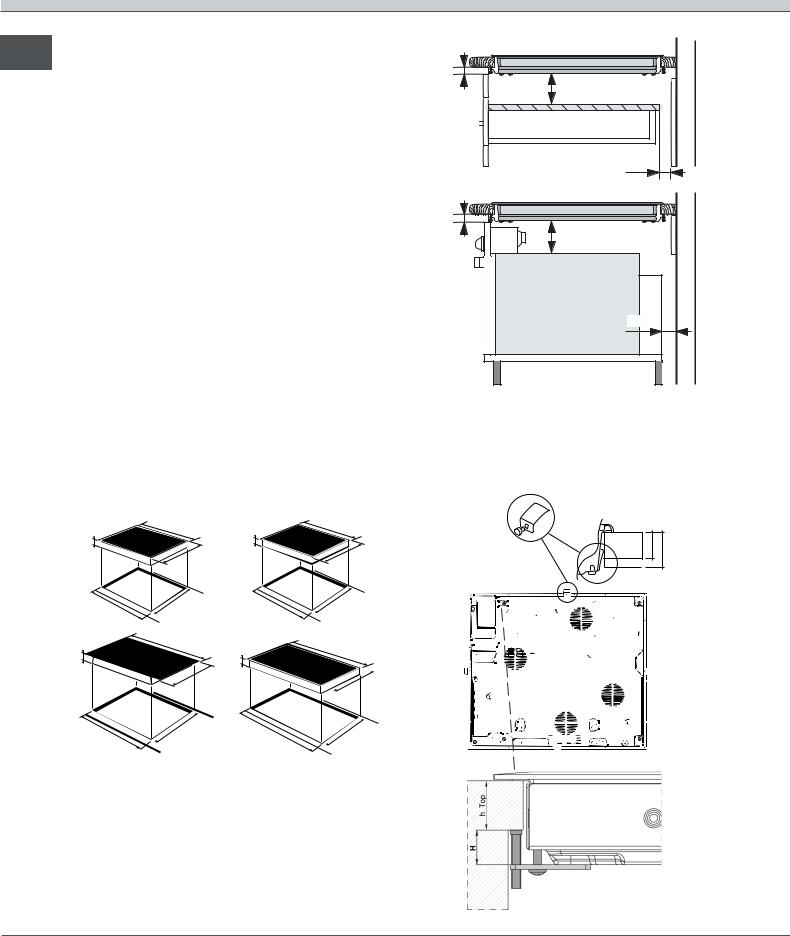
Installazione
È importante conservare questo libretto per poterlo IT consultare in ogni momento. In caso di vendita, di
cessione o di trasloco, assicurarsi che resti insieme all’apparecchio per informare il nuovo proprietario sul funzionamento e sui relativi avvertimenti.
Leggere attentamente le istruzioni: ci sono importanti informazioni sull’installazione, sull’uso e sulla sicurezza.
Posizionamento
Gli imballaggi non sono giocattoli per bambini e vanno eliminati secondo le norme per la raccolta differenziata
(vedi Precauzioni e consigli).
L’installazione va effettuata secondo queste istruzioni e da personale professionalmente qualificato. Una errata installazione può causare danni a persone, animali o cose.
Incasso
Per garantire un buon funzionamento dell’apparecchio è necessario che il mobile abbia le caratteristiche adatte:
•il piano d’appoggio deve essere di materiale resistente al calore, a una temperatura di circa 100°C;
•se si desidera installare il piano cottura sopra un forno, questo deve essere provvisto di un sistema di raffreddamento a ventilazione forzata;
•evitare di installare il piano cottura sopra una lavastoviglie: all’occorrenza frapporre un elemento di separazione a tenuta stagna fra i due apparecchi;
•a seconda del piano cottura che si desidera installare (vedi figure), il vano del mobile deve avere le seguenti dimensioni:
|
|
|
|
|
590 |
|
|
|
|
|
|
574 |
|
48 |
|
|
|
|
|
|
|
48 |
|
|
|
|
504 |
|
|
|
|
|
|
520 |
|
|
|
|
|
||
|
|
|
|
|
|
|
1 |
|
|
|
|
|
1 |
|
|
|
|
|
|
- |
|
|
|
|
|
- |
|
560 |
|
|
|
490 |
+/ |
560 |
|
|
|
490 |
+/ |
||
+/- |
|
|
|
+/ |
|
|
|
||||||
|
|
1 |
|
|
|
|
- |
1 |
|
|
|||
|
|
|
|
|
690 |
|
|
|
|
|
|
785 |
|
|
|
|
|
|
|
|
|
|
|
|
|
|
|
48 |
|
|
|
|
|
|
|
48 |
|
|
|
|
|
|
|
|
|
|
|
|
520 |
|
|
|
|
|
|
|
|
|
|
|
|
|
|
|
|
|
|
|
510 |
|
|
|
|
|
|
|
1 |
|
|
|
|
|
1 |
|
|
|
|
|
|
|
- |
|
|
|
|
|
|
560 |
|
|
|
|
|
|
+/ |
750 |
|
|
|
|
- |
+/- |
|
|
490 |
|
+/ |
|
|
|
490+/ |
||||
|
1 |
|
|
|
|
|
- |
1 |
|
|
|||
|
|
|
|
|
|
|
|
|
|
|
|
||
Aerazione
Per consentire un’adeguata aerazione e per evitare il surriscaldamento delle superfici attorno
all’apparecchio, il piano cottura deve essere posizionato:
•a una distanza minima di 40 mm dalla parete retrostante e di 600 mm da qualsiasi altra superficie verticale;
•in modo da mantenere una distanza minima di 20 mm fra il vano per l’incasso e il mobile sottostante.
min. 20 mm
mm5  CASSETTO
CASSETTO
min. 40 mm
min. 20 mm |
5 mm |
FORNO |
VENTILATO |
min. 40 mm |
Fissaggio |
L’installazione dell’apparecchio deve essere effettuata su un piano d’appoggio perfettamente piano.
Le eventuali deformazioni provocate da un errato fissaggio potrebbero alterare le caratteristiche e le prestazioni del piano cottura.
LATO ANTERIORE
DEL PIANO COTTURA
PIANO DI |
30 |
40 |
APPOGGIO |
PIANO COTTURA
ROVESCIATO
2
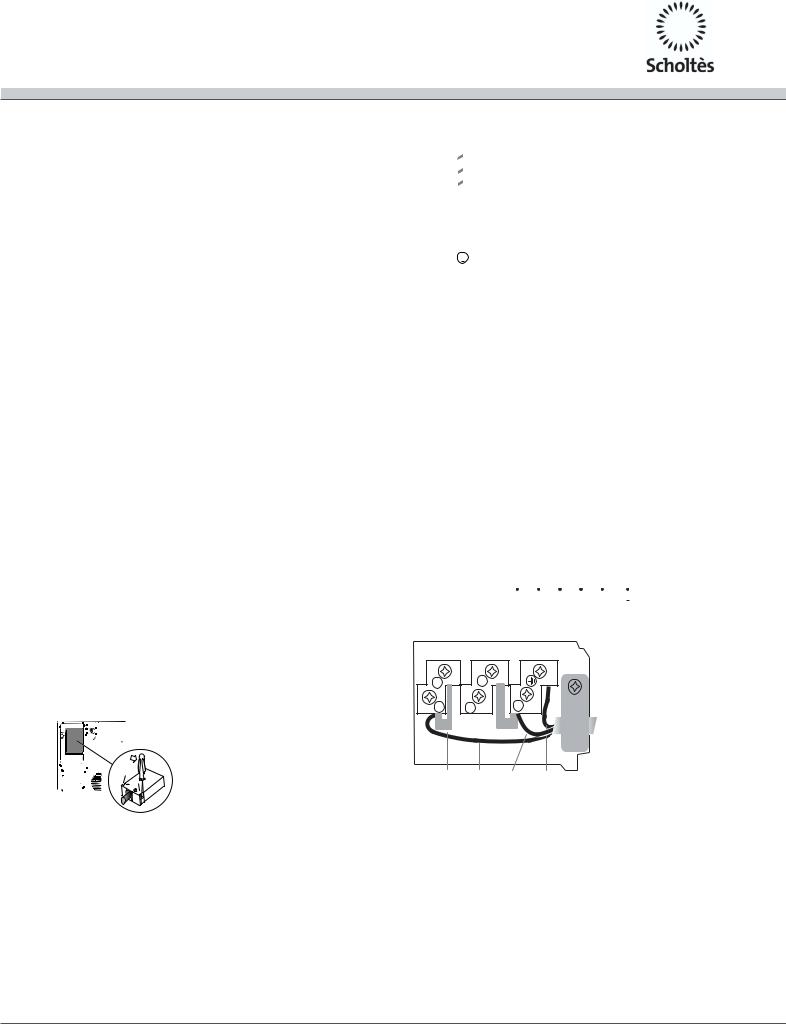
La lunghezza della vite di regolazione dei ganci di fissaggio va impostata prima del loro montaggio, in base allo spessore del piano d’appoggio:
•spessore di 30 mm: vite 23 mm;
•spessore di 40 mm: vite 13 mm.
Per il fissaggio agire come segue:
1.Con le viti corte senza punta, avvitare le 4 molle di centraggio nei fori posti al centro di ogni lato del piano;
2.inserire il piano cottura nel vano del mobile, centrarlo ed esercitare una adeguata pressione sull’intero perimetro affinché il piano di cottura aderisca bene al piano d’appoggio.
3.per i piani con profili laterali: dopo aver inserito il piano cottura nel mobile, inserire i 4 ganci di fissaggio (ognuno con il suo perno) sul perimetro inferiore del piano cottura, avvitandoli con le viti lunghe con punta finché il vetro non aderisce al piano d’appoggio.
È indispensabile che le viti delle molle di centraggio rimangano accessibili.
In conformità alle norme di sicurezza, una volta incassato l’apparecchio, non debbono essere possibili eventuali contatti con le parti elettriche.
Tutte le parti che assicurano la protezione debbono essere fissate in modo tale da non poter essere tolte
senza l’aiuto di qualche utensile.
Collegamento elettrico
L’allacciamento elettrico del piano cottura e quello di un eventuale forno da incasso devono essere realizzati separatamente, sia per ragioni di sicurezza elettrica sia per facilitare le operazioni di estrazione del forno.
Morsettiera
PIANO COTTURA ROVESCIATO
L’apparecchio è provvisto, nella parte inferiore, di una scatola per il collegamento a differenti tipi di alimentazione elettrica (l’immagine è indicativa e può non corrispondere al modello acquistato).
Collegamento monofase
L’eventuale cavo in dotazione è predisposto unicamente per questo tipo di installazioni.
Caratteristiche dell’impianto elettrico: Tensione tipo e frequenza di rete
•230/240V 1+N ~ 50 Hz
•230V 2 ~ 50 Hz
Blu |
Marrone Verde / Giallo Se il piano è dotato di cavo |
|
|||||
IT |
|||||||
|
|
|
|
|
di alimentazione già collegato, |
||
|
|
|
|
|
allacciarlo alla rete rispettando |
|
|
|
|
|
|
|
|||
|
|
|
|
|
il colore dei fili come da schema |
|
|
|
|
|
|
|
a fianco. |
|
|
|
|
|
|
|
|
|
|
Neutre |
|
Phase |
Terre |
|
|||
N |
|
L |
|
|
|
|
|
|
|
|
|
|
|||
Se il piano non è dotato di cavo alimentazione collegato, procedere come segue:
1.Utilizzare il cavo di alimentazione in dotazione (ove presente) o un cavo di alimentazione appropriato, tipo H05VV-F o di valore superiore, delle dimensioni adatte (sezione cavo: 2,5 mm).
2.Servendosi di un cacciavite, far leva sulle linguette del coperchio della morsettiera e aprirla (vedi immagine
Morsettiera).
3.La morsettiera è già predisposta per il collegamento monofase: accertarsi che i cavallotti di collegamento tra i morsetti 1 e 2 e quelli tra 4 e 5 siano in posizione corretta (vedi immagine Monofase).
4.Posizionare i fili in accordo con il disegno e la tabella che seguono ed effettuare il collegamento stringendo a fondo tutte le viti dei morsetti.
Tensione tipo e |
|
Collegamenti elettrici |
|
|
Morsettiera |
||||||
frequenza rete |
|
|
|
||||||||
|
|
|
|
|
|
|
|
|
|
|
|
|
|
|
|
|
|
|
|
|
|
|
|
230/240V 1+N ~ |
|
|
|
|
|
|
|
|
|
|
|
50 Hz |
1 2 |
3 |
4 5 |
|
|
|
Monofase |
||||
|
|
|
|
|
|
|
|
|
|
|
|
|
|
|
|
|
|
|
|
|
|
|
|
230V 2 ~ 50 Hz |
|
|
L |
|
|
N |
|
|
|
|
|
|
|
|
|
|
|
|
|
|
|
|
|
|
|
|
|
|
|
|
|
|
|
|
|
Monofase
2 |
|
4 |
1 |
3 |
5 |
Cavallotto Fase Neutro Terra
5. Fissare il cavo di alimentazione nell’apposito fermacavo e chiudere il coperchio.
3

Altri tipi di collegamento
IT
L’eventuale cavo in dotazione non è utilizzabile per questi tipi di installazione.
Se l’impianto elettrico corrisponde a una delle seguenti caratteristiche:
Tensione tipo e frequenza di rete
•400V 2 - N ~ 50 Hz
•230V 3 ~ 50 Hz
•230V 2 + 2 - N ~ 50 Hz
procedere come segue:
1.Utilizzare un cavo di alimentazione appropriato, tipo H05RR-F o di valore superiore, delle dimensioni adatte (sezione cavo: 1,5 mm).
2.Servendosi di un cacciavite, far leva sulle linguette del coperchio della morsettiera e aprirla (vedi immagine
Morsettiera).
3.Svitare la vite del serracavo e le viti dei morsetti relativi al tipo di allaccio necessario e posizionare i cavallotti di collegamento secondo la tabella e i disegni che seguono.
4.Posizionare i fili in accordo con la tabella e i disegni che seguono ed effettuare il collegamento stringendo a fondo tutte le viti dei morsetti.
Tensione tipo e |
Collegamenti elettrici |
Morsettiera |
||||||
frequenza rete |
||||||||
|
|
|
|
|
|
|||
400V |
2-N ~ |
1 |
2 |
3 |
4 |
5 |
Trifase 400 |
|
50 |
Hz |
L1 |
L2 |
|
|
N |
2+N |
|
1 |
2 |
3 |
4 |
5 |
230V 3 ~ 50 Hz |
|
Trifase 230 |
L1 |
L2 |
L3 |
230V 2+2-N ~ |
1 |
2 |
3 |
4 |
5 |
|
|
Bifase |
||||
|
|
|
|
|
|
|
|
|
|
|
||
50 Hz |
|
|
|
|
|
|
|
|
|
|
|
|
L1 |
L2 |
|
N1 |
N2 |
|
|
|
|||||
5. Fissare il cavo di alimentazione nell’apposito fermacavo e chiudere il coperchio.
Allacciamento del cavo di alimentazione alla rete
In caso di collegamento diretto alla rete è necessario interporre tra l’apparecchio e la rete un interruttore onnipolare con apertura minima fra i contatti di 3 mm.
L’installatore è responsabile del corretto collegamento elettrico e dell’osservanza delle norme di sicurezza.
Prima di effettuare l’allacciamento accertarsi che:
•la presa abbia la messa a terra e sia a norma di legge;
•la presa sia in grado di sopportare il carico massimo di potenza della macchina, indicato nella
targhetta caratteristiche posta sull’apparecchio;
•la tensione di alimentazione sia compresa nei valori della targhetta caratteristiche;
•la presa sia compatibile con la spina dell’apparecchio. In caso contrario sostituire la presa o la spina; non usare prolunghe e multiple.
Ad apparecchio installato, il cavo elettrico e la presa della corrente devono essere facilmente raggiungibili.
Il cavo non deve subire piegature o compressioni.
Il cavo deve essere controllato periodicamente e sostituito solo da tecnici autorizzati.
L’azienda declina ogni responsabilità qualora queste norme non vengano rispettate.
|
|
Bifase |
|
|
Trifase 400 2+N |
2 |
4 |
|
2 |
|
4 |
1 |
3 |
5 |
1 |
3 |
5 |
Fase Fase |
Neutro |
Neutro Terra |
|
|
|
|
|
Fase |
|
Fase |
Cavallotto Neutro Terra |

 1 2
1 2
Fase
Trifase 230
4 |
|
3 |
5 |
Fase Cavallotto |
Fase Terra |
4
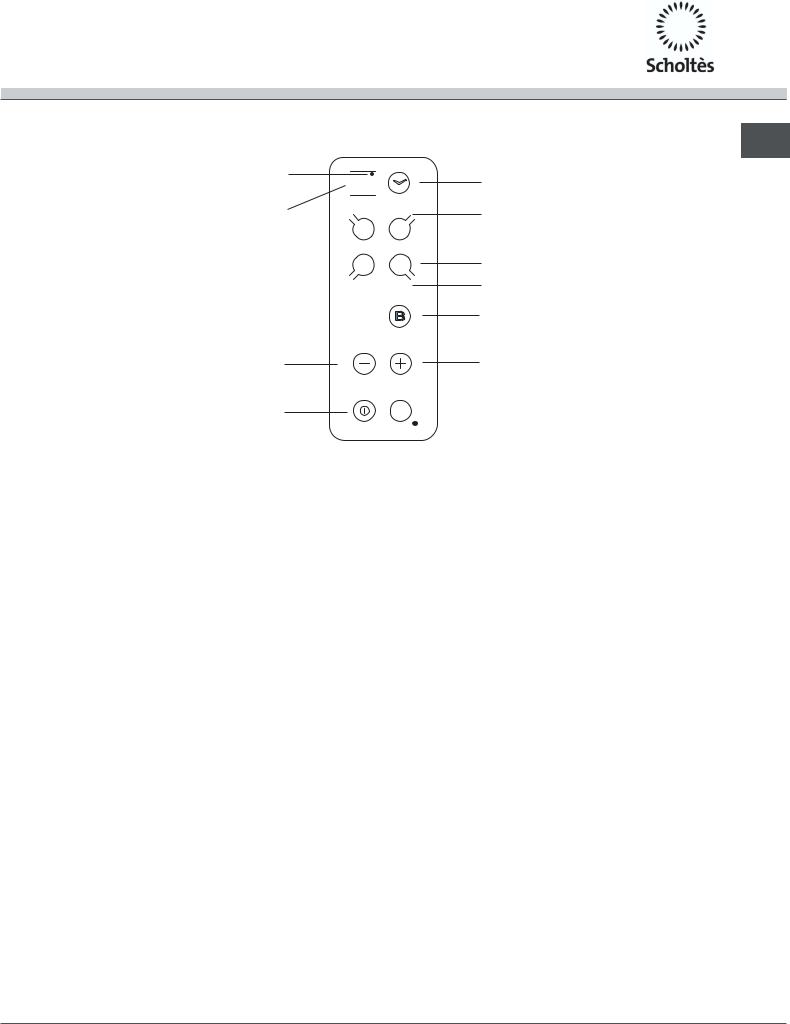
Descrizione dell’apparecchio
Pannello di controllo
Spie |
|
|
|
ZONA DI COTTURA PROGRAMMATA* |
15 |
|
|
Display |
|
||
0 |
5. |
||
TIMER DI PROGRAMMAZIONE* |
|||
|
|
0 0
IT
Tasti
TIMER DI PROGRAMMAZIONE*
Spia
ZONA DI COTTURA SELEZIONATA
Tasto SELEZIONE ZONA DI COTTURA
Indicatore POTENZA
Tasto BOOSTER*
Tasto DIMINUZIONE POTENZA
Tasto ON/OFF
•Display TIMER DI PROGRAMMAZIONE visualizza le scelte relative alla programmazione (vedi Avvio e utilizzo).
•Tasti TIMER DI PROGRAMMAZIONE per regolare la programmazione di ciascuna zona di cottura (vedi Avvio e utilizzo).
•Spie ZONA DI COTTURA PROGRAMMATA indicano che la zona di cottura relativa è stata programmata (vedi Avvio e utilizzo).
•Tasto ON/OFF per accendere e spegnere l’apparecchio.
•Tasto BLOCCO DEI COMANDI per impedire modifiche fortuite alle regolazioni del piano cottura (vedi Avvio e utilizzo).
•Spia COMANDI BLOCCATI segnala l’avvenuto blocco dei comandi (vedi Avvio e utilizzo).
* Presente solo in alcuni modelli.
Tasto AUMENTO POTENZA

 Tasto BLOCCO DEI COMANDI
Tasto BLOCCO DEI COMANDI
 Spia COMANDI BLOCCATI
Spia COMANDI BLOCCATI
•Tasto BOOSTER per accendere la sovralimentazione - 3000 W - della zona di cottura (vedi Avvio e utilizzo).
•Spia ZONA DI COTTURA SELEZIONATA indica che la zona di cottura relativa è stata selezionata e quindi sono possibili le varie regolazioni
•Tasto SELEZIONE ZONA DI COTTURA per selezionare la zona di cottura desiderata
•Indicatore POTENZA segnala visivamente il livello di calore raggiunto.
•Tasto AUMENTO POTENZA per accendere la piastra e regolare la potenza (vedi Avvio e utilizzo).
•Tasto DIMINUZIONE POTENZA per regolare la potenza e spegnere la piastra (vedi Avvio e utilizzo).
5

Avvio e utilizzo
La colla applicata sulle guarnizioni lascia alcune IT tracce di grasso sul vetro. Prima di utilizzare
l’apparecchio, si raccomanda di eliminarle con un prodotto specifico per la manutenzione non abrasivo. Durante le prime ore di funzionamento è possibile avvertire un odore di gomma, che comunque scomparirà presto.
Quando il piano cottura viene collegato elettricamente, dopo acuni secondi viene emesso un breve segnale acustico. Soltanto a questo punto è possibile accendere il piano cottura.
Accensione del piano cottura
L’accensione del piano cottura avviene tenendo premuto il tasto  per circa un secondo.
per circa un secondo.
Accensione delle zone di cottura
Ciascuna zona di cottura viene azionata tramite il dispositivo di regolazione della potenza composto da due tasti (- e +).
•Premere il tasto “+” per attivare la piastra, poi impostare la potenza desiderata agendo sui tasti “- ” e “+”.
•Per impostare direttamente la potenza massima, premere brevemente il tasto “-”.
Funzione booster*
Per accelerare i tempi di riscaldamento, nelle zone di cottura posteriori è possibile attivare la funzione booster premendo il tasto  .Sul diaply indicatore della potenza appare “P”. Questa funzione sovralimenta a 3000 W la zona di cottura interessata. Il booster si interrompe automaticamente dopo 4 minuti. Finché il booster di una delle zone di cottura posteriori è attivo, la zona
.Sul diaply indicatore della potenza appare “P”. Questa funzione sovralimenta a 3000 W la zona di cottura interessata. Il booster si interrompe automaticamente dopo 4 minuti. Finché il booster di una delle zone di cottura posteriori è attivo, la zona
di cottura anteriore relativa è limitata alla potenza massima di 600 W (es: se è attivo il booster nella piastra posteriore sinistra, si abbassa la potenza della piastra anteriore sinistra).
Zone di cottura ovali*: possono essere sovralimentate soltanto se è attivato l’intero ovale.
Non mettere due pentole piccole sulle zone di cottura ovali.
Spegnimento delle zone di cottura
•Premere il tasto “-”: la potenza della zona di cottura scende progressivamente, fino allo spegnimento.
•Oppure premere contemporaneamente i tasti “-” e “+”: la potenza torna immediatamente a 0 e la zona di cottura si spegne.
Programmazione della durata di una cottura*
È possibile programmare tutte le zone di cottura per una durata compresa tra 1 e 99 minuti.
1.Selezionare la zona di cottura tramite il tasto di selezione corrispondente.
2.Regolarne la temperatura.
3. Premere il tasto di programamzione |
. |
3.Impostare la durata di cottura desiderata tramite i tasti “-” e “+”.
4.Confermare premendo il tasto  .
.
Il conto alla rovescia del timer ha inizio immediatamente. La fine della cottura programmata è indicata da un segnale acustico (per la durata di 1 minuto) e la zona di cottura si spegne.
Ripetere la procedura sopra descritta per ogni piastra che si intende programmare.
Blocco dei comandi
Quando il piano cottura è in funzione, è possibile bloccare i comandi per evitare il rischio di modifiche fortuite alle regolazioni (bambini, operazioni di pulizia, ecc.). Premendo il tasto  i comandi si bloccano e la spia che si trova sopra al tasto si accende. Per tornare ad agire sulle regolazioni (es. interrompere la cottura) è necessario sbloccare i comandi: premere il tasto
i comandi si bloccano e la spia che si trova sopra al tasto si accende. Per tornare ad agire sulle regolazioni (es. interrompere la cottura) è necessario sbloccare i comandi: premere il tasto  per qualche istante, la spia si spegne e i comandi si sbloccano.
per qualche istante, la spia si spegne e i comandi si sbloccano.
Spegnimento del piano cottura
Premendo il tasto  l’apparecchio si spegne.
l’apparecchio si spegne.
Se i comandi dell’apparecchio sono stati bloccati, continueranno ad essere bloccati anche dopo aver riacceso il piano di cottura. Per poter riaccendere il piano è necessario prima sbloccare i comandi.
* Presente solo in alcuni modelli.
6
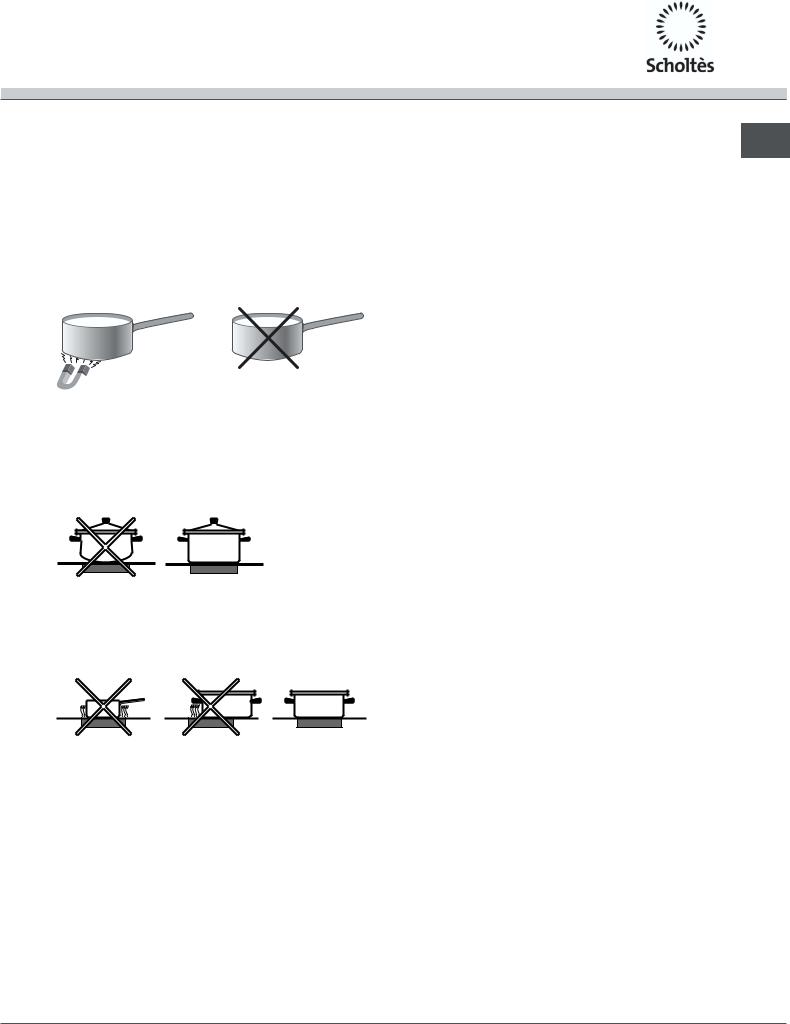
Consigli pratici per l’uso dell’apparecchio
Adoperare recipienti di cottura il cui materiale di fabbricazione sia compatibile con il principio dell’induzione (materiale ferromagnetico). Si raccomanda l’uso di pentole in: ghisa, acciaio smaltato o inox speciale per induzione. Per sincerarsi della compatibilità di un recipiente è sufficiente fare una prova con una calamita.
MATERIALE ADATTO |
MATERIALE NON ADATTO |
Ghisa |
Rame, |
Acciaio smaltato |
Alluminio, Vetro, Terracotta, |
Inox speciale |
Ceramica, Inox non magnetico |
Inoltre, per ottenere le migliori prestazioni dal piano di cottura:
•Adoperare pentole con fondo piatto e di elevato spessore, per essere certi che aderiscano perfettamente alla zona riscaldante.
•Adoperare pentole di diametro sufficiente a coprire completamente la zona riscaldante, in modo da garantire lo sfruttamento di tutto il calore disponibile.
•Accertarsi che il fondo delle pentole sia sempre perfettamente asciutto e pulito, per garantire la corretta aderenza e una lunga durata, sia alle zone di cottura che alle pentole stesse.
•Evitare di utilizzare le stesse pentole utilizzate
sui bruciatori a gas: la concentrazione di calore sui bruciatori a gas può deformare il fondo della pentola, che perde aderenza.
Dispositivi di sicurezza
IT
Rilevamento dei recipienti
Ciascuna zona di cottura è provvista di un dispositivo di rilevamento della pentola. La piastra emette calore unicamente in presenza di una pentola di dimensioni adeguate alla zona di cottura stessa. La spia lampeggiante può indicare:
•una pentola incompatibile
•una pentola di diametro insufficiente
•il sollevamento della pentola
Indicatori di calore residuo
Finché la temperatura delle zone di cottura rimane superiore a 60°C, anche dopo l’arresto gli indicatori di calore residuo situati vicino alla zona di cottura relativa restano accesi per prevenire il rischio di ustioni.
Surriscaldamento
In caso di surriscaldamento dei componenti elettronici, il piano cottura si spegne automaticamente e sul display appare “—”. Questo messaggio scompare e il piano torna utilizzabile non appena la temperatura è scesa a un livello accettabile.
Interruttore di sicurezza
L’apparecchio è dotato di un interruttore di sicurezza che spegne le zone di cottura automaticamente quando viene raggiunto un tempo limite di utilizzo a un dato livello di potenza. Durante l’interruzione di sicurezza, il display indica “0”.
Esempio: la piastra posteriore destra è impostata su 5, mentre la piastra anteriore sinistra su 2. La posteriore destra si spegnerà dopo 3 ore di funzionamento, la anteriore sinistra dopo 10 ore.
Segnale acustico
Alcune anomalie, quali:
•un oggetto (pentola, posata, ecc.) posto per oltre 10 secondi sull’area dei comandi,
•un versamento sull’area dei comandi,
•una pressione esercitata a lungo su un tasto, possono provocare l’emissione di un segnale acustico. Rimuovere la causa del malfunzionamento per interrompere il segnale acustico. In queste situazioni i comandi si bloccano automaticamente: per sbloccarli premere il tasto [icona chiave], le impostazioni vengono mantenute. Se la causa dell’anomalia non viene rimossa, il segnale acustico persiste e il piano si spegne.
7
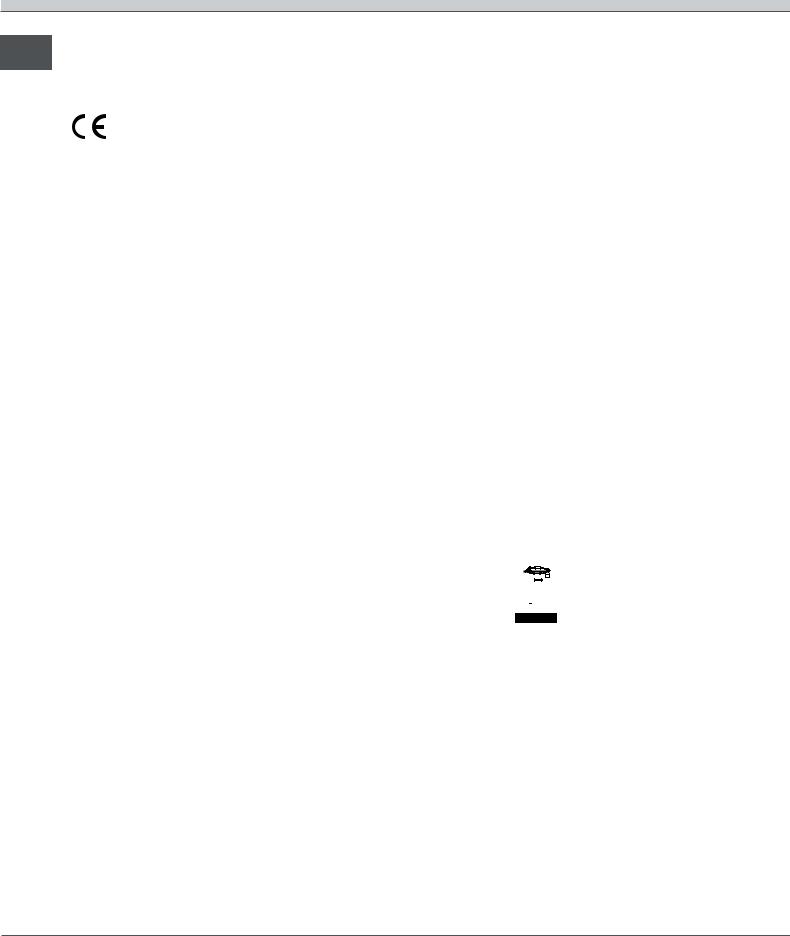
Precauzioni e consigli
L’apparecchio è stato progettato e costruito
IT in conformità alle norme internazionali di sicurezza. Queste avvertenze sono fornite per ragioni di sicurezza e devono essere lette attentamente.
Questa apparecchiatura è conforme alle seguenti Direttive Comunitarie:
-73/23/CEE del 19/02/73 (Bassa Tensione) e successive modificazioni
-89/336/CEE del 03/05/89 (Compatibilità Elettromagnetica) e successive modificazioni
-93/68/CEE del 22/07/93 e successive modificazioni.
-2002/96/CE
Sicurezza generale
Controllare che la presa d'aria tramite la griglia del ventilatore non sia mai ostruita. Il piano da incasso, infatti, necessita di una corretta aerazione per il raffreddamento dei componenti elettronici.
È sconsigliata l'installazione di un piano cottura a induzione sopra un frigorifero sottotavolo (calore) o sopra una lavatrice (vibrazioni). Lo spazio necessario per la ventilazione degli elementi elettronici sarebbe infatti insufficiente.
• L’apparecchio è stato concepito per un uso di tipo non professionale all’interno dell’abitazione.
• L’apparecchio non va installato all’aperto, nemmeno se lo spazio è riparato, perché è molto pericoloso lasciarlo esposto a pioggia e temporali.
• Non toccare la macchina a piedi nudi o con le mani o i piedi bagnati o umidi.
• L’apparecchio deve essere usato per cuocere alimenti, solo da persone adulte e secondo le istruzioni riportate in questo libretto. Non utilizzare il piano come superficie di appoggio, né come tagliere.
• Il piano in vetroceramica è resistente agli urti meccanici, tuttavia può incrinarsi (o eventualmente frantumarsi) se colpito con un oggetto appuntito, quale un utensile. In questi casi, scollegare immediatamente l’apparecchio dalla rete di alimentazione e rivolgersi all’Assistenza.
• Se la superficie del piano è incrinata, spegnere l'apparecchio per evitare la possibilità di scosse elettriche.
• Evitare che il cavo di alimentazione di altri elettrodomestici entri in contatto con parti calde del piano cottura.
• Non dimenticare che la temperatura delle zone di cottura rimane piuttosto elevata per almeno trenta minuti dopo lo spegnimento. Il calore residuo è segnalato anche da un indicatore (vedi Avvio e utilizzo).
• Tenere a debita distanza dal piano cottura qualsiasi oggetto che potrebbe fondere, ad esempio oggetti in plastica, in alluminio o prodotti con un elevato
contenuto di zucchero. Fare particolare attenzione a imballaggi e pellicole in plastica o alluminio:
se dimenticati sulle superfici ancora calde o tiepide possono causare un grave danno al piano.
•Assicurarsi che i manici delle pentole siano sempre rivolti verso l’interno del piano cottura per evitare che vengano urtati accidentalmente.
•Non staccare la spina dalla presa della corrente tirando il cavo, bensì afferrando la spina.
•Non fare pulizia o manutenzione senza aver prima staccato la spina dalla rete elettrica.
•Non posare oggetti metallici (coltelli, cucchiai, coperchi, ecc.) sul piano perchè possono diventare caldi.
•Avvertenza per i portatori di pacemaker o altri dispositivi medici impiantabili attivi:
Il piano cottura è conforme a tutte le normative vigenti in materia di interferenze elettromagnetiche.
Questo prodotto è pertanto perfettamente rispondente a tutti i requisiti di legge (direttive 89/336/CEE). È stato progettato in modo da non creare inferenze ad altre apparecchiature elettriche utilizzate, a condizione che anche queste siano conformi alle suddette normative. Il piano cottura a induzione genera campi elettromagnetici a breve portata.
Per evitare ogni rischio di interferenze tra il piano di cottura e il pacemaker, quest'ultimo dovrà essere realizzato in conformità alle normative vigenti.
A tale riguardo, possiamo garantire unicamente la conformità del nostro prodotto. Per informazioni sulla conformità o eventuali problemi di incompatibilità, si prega di rivolgersi al proprio medico curante o alla casa produttrice del pacemaker.
Smaltimento 
•Smaltimento del materiale di imballaggio: attenersi alle norme locali, così gli imballaggi potranno essere riutilizzati.
•La direttiva Europea 2002/96/CE sui rifiuti di apparecchiature elettriche ed elettroniche (RAEE), prevede che gli elettrodomestici non debbano essere smaltiti nel normale flusso dei rifiuti solidi urbani. Gli apparecchi dismessi devono essere raccolti separatamente per ottimizzare il tasso di recupero e riciclaggio dei materiali che li compongono ed impedire potenziali danni per la salute e l’ambiente. Il simbolo del cestino barrato è riportato su tutti i prodotti per ricordare gli obblighi di raccolta separata. Per ulteriori informazioni, sulla corretta dismissione degli elettrodomestici, i detentori potranno rivolgersi al servizio pubblico preposto o ai rivenditori.
8

Manutenzione e cura
Escludere la corrente elettrica
Prima di ogni operazione isolare l’apparecchio dalla rete di alimentazione elettrica.
Pulire l’apparecchio
Evitare l’uso di detergenti abrasivi o corrosivi, quali i prodotti in bombolette spray per barbecue e forni, smacchiatori e prodotti antiruggine, i detersivi in polvere e le spugne con superficie abrasiva: possono graffiare irrimediabilmente la superficie.
Non utilizzare mai pulitori a vapore o ad alta pressione per la pulizia dell’apparecchio.
•Per una manutenzione ordinaria, è sufficiente lavare il piano con una spugna umida, asciugando quindi con una carta assorbente per cucina.
•Se il piano è particolarmente sporco, strofinare con un prodotto specifico per la pulizia delle superfici in vetroceramica, sciacquare e asciugare.
•Per rimuovere gli accumuli di sporco più consistenti servirsi dell’apposito raschietto fornito in dotazione. Intervenire non appena possibile, senza attendere che l’apparecchio si sia raffreddato, per evitare l’incrostazione dei residui. Eccellenti risultati si possono ottenere usando una spugnetta in filo d’acciaio inossidabile - specifica per piani in vetroceramica - imbevuta di acqua e sapone.
Il raschietto in dotazione è tagliente: utilizzarlo con attenzione.
•In caso sul piano cottura si fossero accidentalmente fusi oggetti o materiali quali plastica o zucchero, rimuoverli con il raschietto immediatamente, finché la superficie è ancora calda.
•Una volta pulito, il piano può essere trattato con un prodotto specifico per la manutenzione e la protezione: la pellicola invisibile lasciata da questo prodotto protegge la superficie in caso di scolamenti durante la cottura. Si raccomanda
di eseguire queste operazioni con l’apparecchio tiepido o freddo.
•Ricordarsi sempre di risciacquare con acqua pulita e asciugare accuratamente il piano: i residui di prodotti potrebbero infatti incrostarsi durante la successiva cottura.
Telaio in acciaio inox
(solo nei modelli con cornice)
L’acciaio inossidabile può macchiarsi per effetto
di un’acqua molto calcarea lasciata per un periodo di IT tempo prolungato a contatto dello stesso oppure a
causa di prodotti per la pulizia contenenti fosforo. Si consiglia di sciacquare abbondantemente e asciugare con cura dopo la pulizia del piano. In caso di versamenti d’acqua, intervenire rapidamente asciugando con cura.
Smontare il piano
Nel caso si renda necessario smontare il piano cottura:
1.togliere le viti che fissano le molle di centraggio sui lati;
2.allentare le viti dei ganci di fissaggio sugli angoli;
3.estrarre il piano cottura dal vano del mobile.
Raccomandiamo di evitare di accedere ai meccanismi interni per tentare una riparazione. In caso di guasto, contattare l’Assistenza.
9

Descrizione tecnica delle zone di cottura
Il sistema a induzione è il procedimento di cottura più rapido che esista. A differenza delle piastre tradizionali, IT non è la zona di cottura che si riscalda: il calore viene generato direttamente all’interno della pentola, la quale
dovrà possedere necessariamente un fondo in materiale ferromagnetico.
PIANI COTTURA |
TI 8624 |
TI 7624 |
|
TI 8624 400 |
TI 7624 400 |
||
|
|||
Zone di cottura |
Potenza |
Potenza |
|
Posteriore destro |
IO 1200/2400 W – B 3000 W |
ID 2400 W – B 3000 W |
|
Anteriore destro |
I 1200 W – 600 W se* |
I 1200 W – 600 W se* |
|
Anteriore sinistro |
ID 2400 W – B 3000 W |
IO 1200/2400 W – B 3000 W |
|
Posteriore sinistro |
I 1200 W – 600 W se* |
I 1200 W – 600 W se * |
|
Potenza max totale |
7200 |
7200 |
|
|
|
|
|
PIANI COTTURA |
TI 6523 |
TI 6514 |
|
TI 6514 400 |
|||
|
|
||
Zone di cottura |
Potenza |
Potenza |
|
Posteriore destro |
I 1200 W – 600 W se* |
ID 1800 W – B 3000 W |
|
Anteriore destro |
IO 1200/2400 W – B 3000 W |
I 1200 W – 600 W se* |
|
Anteriore sinistro |
I 1800 W |
||
|
|||
Posteriore sinistro |
ID 1800 W – B 3000 W |
I 1200 W |
|
Potenza max totale |
6600 W |
6600 W |
Legenda:
I = zona di cottura a induzione semplice
IO= zona di cottura a induzione ovale
ID = zona di cottura a induzione doppia
B = booster: la zona di cottura può essere sovralimentata a 3000 W
*= la potenza massima è limitata a 600 W finché è attivo il booster nella zona di cottura posteriore relativa (vedi Avvio e utilizzo).
10

Operating Instructions
HOB
|
|
|
|
|
|
|
|
|
|
|
|
|
|
|
Contents |
|
|
|
|
|
|
|
|
GB |
|
|
|
|
|
|
|
|
|
|
|
|
|
|
|
|
|
Installation, 12-14 |
|
|
|
IT |
|
GB |
|
FR |
|
|
|
|
|
|
Positioning |
|
||||
|
|
|
|
|
|
Electrical connections |
|
|
|
|
|
|
|
|
|
||
Italiano, 1 English,11 Français, 21
NL |
|
DE |
|
PT |
|
|
|
|
|
|
|
Nederlands, 31 |
Deutsch, 41 |
Português, 51 |
|||
ES
Español, 61
TI 8624
TI 8624 400
TI 7624
TI 7624 400
TI 6514
TI 6514 400
TI 6523
Description of the appliance, 15
Control panel
Start-up and use, 16-17
Switching on the hob Switching on the cooking zones Booster function
Switching off the cooking zones Programming the cooking time Control panel lock Spegnimento del piano cottura
Practical advice on using the appliance Safety devices
Precautions and tips, 18
General safety Disposal
Maintenance and care, 19
Switching the appliance off Cleaning the appliance Removing the hob
Technical description of models, 20
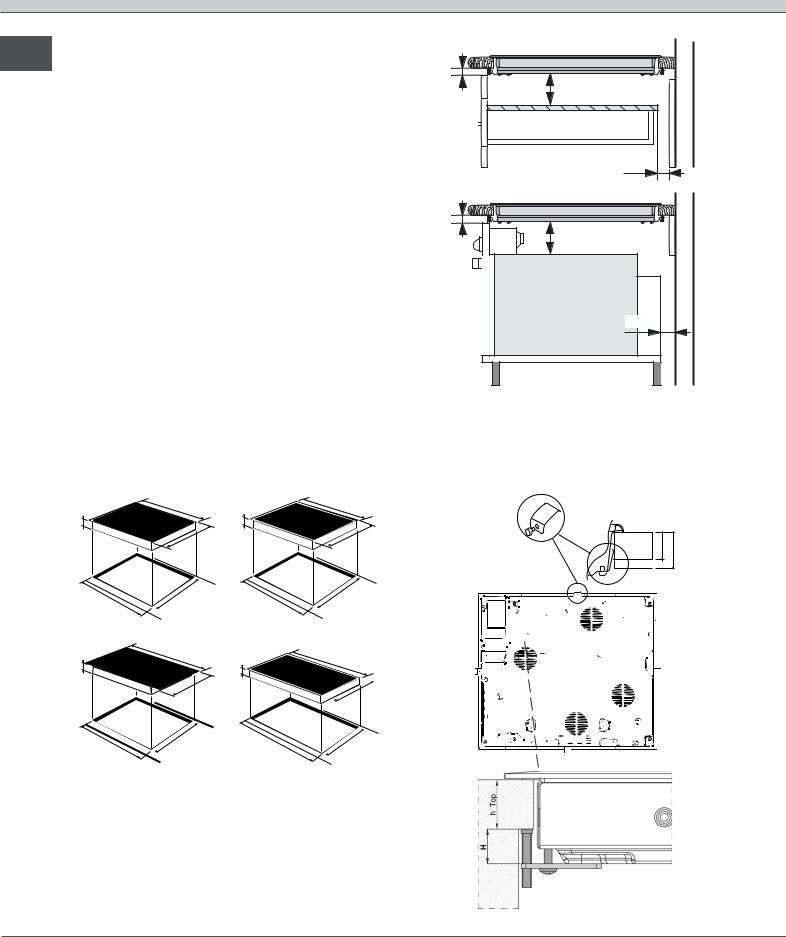
Installation
Before operating your new appliance please read this GB instruction booklet carefully. It contains important
information for safe use, installation and care of the appliance.
Please keep these operating instructions for future reference. Pass them on to possible new owners of the appliance.
Positioning
Keep packaging material out of the reach of children. It can become a choking or suffocation hazard (see
Precautions and tips).
The appliance must be installed by a qualified person according to the instructions provided. Incorrect installation may damage property or cause harm to people or animals.
Fitting the appliance
Use the appropriate cabinet to ensure that the appliance functions properly.
•The supporting surface must be heat-resistant up to a temperature of around 100°C
•if the appliance is to be installed above an oven, the oven must have a forced ventilation cooling system
•avoid installing the hob above a dishwasher: if this cannot be avoided, place a separation device at a static distance between the two appliances
•depending on the hob you want to install the cabinet must have the following dimensions (see figure):
|
|
|
590 |
|
|
|
|
|
574 |
|
48 |
|
|
|
|
48 |
|
|
|
|
504 |
|
|
|
|
520 |
|
|
|
|
|
|
|
|
|
|
1 |
|
|
|
|
|
1 |
|
|
|
|
- |
|
|
|
|
|
- |
560 |
|
|
490 |
+/ |
560 |
|
|
|
490 |
+/ |
+/- |
|
|
+/ |
|
|
|
||||
|
|
|
|
|
|
|
||||
|
1 |
|
|
|
- |
1 |
|
|
|
|
|
|
|
|
|
|
|
|
|
||
|
|
|
690 |
|
|
|
|
|
785 |
|
|
|
|
|
|
|
|
|
|
|
|
48 |
|
|
|
|
48 |
|
|
|
|
|
|
|
|
|
520 |
|
|
|
|
|
|
|
|
|
|
|
|
|
|
|
|
510 |
|
|
|
|
1 |
|
|
|
|
|
1 |
|
|
|
|
- |
|
|
|
|
|
|
560 |
|
|
|
+/ |
750 +/ |
|
|
- |
||
+/- |
|
490 |
|
|
490+/ |
|||||
|
1 |
|
|
|
|
- |
1 |
|
|
|
|
|
|
|
|
|
|
|
|
||
Ventilation
To allow adequate ventilation and to avoid
overheating of the surrounding surfaces the hob should be positioned:
•At a minimum of 40 mm from the back panel and 600 mm from any other vertical surfaces.
•maintaining a minimum distance of 20 mm between the installation cavity and the cabinet underneath.
min. 20 mm
mm5  COMPARTMENT
COMPARTMENT
min. 40 mm
min. 20 mm |
5 mm |
FAN-ASSISTED |
OVEN |
min. 40 mm |
Fixing
The appliance must be installed on a perfectly level supporting surface.
Any deformities caused by improper fixing could change the features and the operation of the hob.
FRONT SIDE OF HOB
SUPPORTING |
30 |
40 |
SURFACE |
UNDERSIDE OF HOB
h Wortop
12

The thickness of the supporting surface should be taken into account when choosing screws for the fixing hooks:
•thickness of 30 mm: 23 mm screws
•thickness of 40 mm: 13 mm screws
Fix the appliance as follows:
1.Use short flat-bottomed screws to fix the 4 alignment springs in the holes provided in the centre of each side of the hob.
2.Insert the hob in the cavity, make sure it is in a central position and push down on the whole perimeter until the hob is stuck to the supporting surface.
3.for hobs with raised sides: after inserting the hob into its cavity, insert the 4 fixing hooks (each has its own pin) into the lower edges of the hob, using the long pointed screws to fix it in place, until the glass is stuck to the supporting surface.
The screws for the alignment springs must remain accessible.
In order to adhere to safety standards, the appliance must not come into contact with electrical parts once it has been installed.
All parts that ensure the safe operation of the appliance must not be removable without the aid of a tool.
Electrical connection
The electrical connection of the hob and any built-in oven must be carried out separately, both for safety purposes and to make extracting the oven easier.
Terminal board
|
On the lower part of the |
UNDERSIDE OF HOB |
appliance there is a connection |
|
box for the different types of |
|
electricity supply (the picture is |
|
only an indication and is not an |
|
exact representation of the |
|
purchased model). |
Single-phase connection
The cable provided should only be used for this type of installation.
Mains supply characteristics:
Voltage and mains frequency
•230/240V 1+N ~ 50 Hz
•230V 2 ~ 50 Hz
Blue Brown Green/Yellow If the hob has a supply cable fitted, |
|
|||||
GB |
||||||
|
|
|
|
connect it to the mains, using the |
||
|
|
|
|
colours as a guide (see diagram). |
|
|
|
|
|
|
|
||
|
|
|
|
|
|
|
|
|
|
|
|
|
|
Neutral |
Live |
Earth |
||
N |
L |
|
|
|
|
|
|
||
|
|
|
||
If the hob does not have a supply cable fitted, proceed as follows:
1.Use the supply cable provided (where applicable) or a suitable supply cable, H05VV-F or higher, with the right dimensions (cable section: 2.5 mm).
2.To open the terminal board, insert a screwdriver into the side tabs of the cover (see Terminal board picture).
3.The terminal board is designed for single-phase connection: make sure the connection supports between springs 1 and 2 and those between 4 and 5 are in the right position (see Single-phase picture).
4.Position the wires according to the following diagram and table and connect the appliance by tightening all the screws for the springs as much as possible.
Voltage and
mains Electrical connections
Terminal
frequency
board
230/240V 1+N ~ 1 2 3 |
4 5 |
|
|
|
|
|
Single- |
|||||
|
|
|
|
|
|
|
|
|
|
|
|
|
50 Hz |
|
|
|
|
|
|
|
|
|
phase |
||
|
|
L |
|
N |
|
|
|
|||||
230V 2 ~ 50 Hz |
|
|
|
|
|
|
|
|
|
|||
|
|
|
|
|
|
|
|
|
|
|
|
|
Single-phase
2 |
|
4 |
1 |
3 |
5 |
U-bolt Phase Neutral Earth connection support
5. Secure the power supply cable by fastening the clamp screw then put the cover back on.
13

Other types of connection
GB
The cable provided is not suitable for the following types of installation.
If the mains supply corresponds with one of the following:
Voltage and mains frequency
•400V 2 - N ~ 50 Hz
•230V 3 ~ 50 Hz
•230V 2 + 2 - N ~ 50 Hz
proceed as follows:
1.Use a suitable supply cable, H05RR-F or higher, with the right dimensions (cable section: 1.5 mm).
2.To open the terminal board, insert a screwdriver into the side tabs of the cover (see Terminal board picture).
3.Loosen the cable clamp screw and the terminal board screws according to the type of connection required and position the connection supports as shown in the following table and diagrams.
4.Position the wires according to the following table and diagrams and connect the appliance by tightening all the screws for the springs as much as possible.
Voltage and
mains Electrical connections
Terminal
frequency
board
400V |
2-N ~ |
1 |
2 |
3 |
4 |
5 |
|
|
|
|
|
Three-phase |
|||||
|
|
|
|
|
|
|
|
||||||||||
50 |
Hz |
|
|
|
|
|
|
|
|
|
|
|
|
|
400 2+N |
||
|
|
|
|
|
|
|
|
|
|
|
|
|
|
|
|||
L1 |
L2 |
|
|
|
|
N |
|
|
|
|
|||||||
|
|
|
|
|
|
|
|
|
|
|
|
|
|
|
|
|
|
230V 3 ~ 50 Hz |
1 |
2 |
3 |
4 |
5 |
|
|
|
|
|
Three-phase |
||||||
|
|
|
|
|
|
|
|
|
|
|
|
|
|
|
|||
|
|
|
|
|
|
|
|
|
|
|
|
|
|
230 |
|||
|
|
L1 |
L2 |
|
|
|
|
L3 |
|
|
|
|
|||||
|
|
|
|
|
|
|
|
|
|
|
|
|
|
|
|
|
|
230V 2+2-N ~ |
1 |
2 |
3 |
4 |
5 |
|
|
|
|
|
Two-phase |
||||||
50 |
Hz |
|
|
|
|
|
|
|
|
|
|
|
|
|
|
|
|
|
|
|
|
|
|
|
|
|
|
|
|
|
|
||||
L1 |
L2 |
|
N1 |
N2 |
|
|
|
|
|||||||||
Two-phase
2 |
|
4 |
1 |
3 |
5 |
Phase Phase Neutral Neutral Earth
5. Secure the power supply cable by fastening the clamp screw then put the cover back on.
Connecting the supply cable to the mains
If the appliance is being connected directly to the mains an omnipolar circuit-breaker must be installed with a minimum opening of 3 mm between contacts.
The installer must ensure that the correct electrical connection has been made and that it is compliant with safety regulations.
Before connecting to the power supply, make sure that:
•The appliance is earthed and the plug is compliant with the law.
•The socket can withstand the maximum power of the appliance, which is indicated on the attached data plate.
•The power supply voltage is in the range between the values indicated on the data plate.
•The socket is compatible with the plug of the appliance. If the socket is incompatible with the plug, ask an authorised technician to replace it. Do not use extension cords or multiple sockets.
Once the appliance has been installed, the power supply cable and the electrical socket must be easily accessible.
The cable must not be bent or compressed.
The cable must be checked regularly and replaced by authorised technicians only.
The manufacturer declines any liability should these safety measures not be observed.
Three-phase 400 2+N
2 |
|
4 |
1 |
3 |
5 |
Phase Phase U-bolt Neutral Earth connection
support
Three-phase 230
2 |
4 |
|
1 |
3 |
5 |
Phase |
Phase |
Phase Earth |
|
U-bolt |
|
|
connection |
|
|
support |
|
14

Description |
|
|
|
|
|
|
|
|
|
|
|
|||||
of the appliance |
|
|
|
|
|
|
|
|
|
|||||||
|
|
|
|
|
|
|
|
|
|
|
|
|
|
|
|
|
|
|
|
|
|
|
|
|
|
|
|
|
|
|
|
|
|
Control panel |
|
|
|
|
|
|
|
|
|
|
|
|||||
|
|
|
|
|
|
|
|
|
GB |
|||||||
|
|
|
|
|
|
|
|
|
|
|
|
|
|
|
||
|
COOKING ZONE PROGRAMMED |
|
|
|
|
|
|
|
|
|
|
|
||||
|
|
|
|
|
|
|
|
|
|
|
|
|||||
|
indicator light* |
|
|
|
|
|
|
|
|
|
PROGRAMME TIMER button* |
|||||
|
|
15 |
|
|
|
|
|
|
||||||||
|
|
|
|
|
|
|
||||||||||
|
PROGRAMME TIMER display* |
0 |
|
5. |
|
|
|
|
|
COOKING ZONE SELECTED |
||||||
|
|
|
|
|
|
|
|
|
|
|
|
|
|
indicator light |
||
|
|
|
|
|
|
0 |
|
0 |
|
|
|
|
|
COOKING ZONE SELECTOR button |
||
|
|
|
|
|
|
|
|
|
|
|
|
|||||
|
|
|
|
|
|
|
|
|
|
|
|
POWER indicator |
||||
|
|
|
|
|
|
|
|
|
|
|
||||||
|
|
|
|
|
|
|
|
|
|
|
|
|
|
BOOSTER button* |
||
|
|
|
|
|
|
|
|
|
|
|
|
|
|
|||
|
REDUCE POWER button |
|
|
|
|
|
|
|
|
|
|
|
INCREASE POWER button |
|||
|
|
|
|
|
|
|
|
|
|
|
|
|||||
|
|
|
|
|
|
|
|
|
|
|
|
|
|
CONTROL PANEL LOCK button |
||
|
|
|
|
|
|
|
|
|
|
|
|
|
|
|||
|
ON/OFF button |
|
|
|
|
|
|
|
|
|
|
|
||||
|
|
|
|
|
|
|
|
|
|
|
|
|
|
CONTROL PANEL LOCK indicator |
||
|
|
|
|
|
|
|
|
|
|
|
|
|
|
light |
||
• |
PROGRAMME TIMER display shows the |
|
|
• BOOSTER button switches on the booster function |
||||||||||||
|
programme chosen (see Start-up and use). |
|
|
|
|
|
- 3000W - of the cooking zone (see Start-up and |
|||||||||
• |
PROGRAMME TIMER button controls the |
|
|
|
|
|
use). |
|||||||||
|
programmes for each cooking zone (see Start-up |
|
|
• |
COOKING ZONE SELECTED indicator light shows |
|||||||||||
|
and use). |
|
|
|
|
|
that a particular cooking zone has been selected |
|||||||||
• |
COOKING ZONE PROGRAMMED indicator light |
|
|
|
|
|
and so various controls may be used. |
|||||||||
|
shows that a particular cooking zone has been |
|
|
• |
COOKING ZONE SELECTOR button can be used |
|||||||||||
|
programmed (see Start-up and use). |
|
|
|
|
|
to select the required cooking zone. |
|||||||||
• ON/OFF button switches the appliance on and off. |
• POWER indicator provides a visual display for the |
|||||||||||||||
• |
CONTROL PANEL LOCK button prevents |
|
|
|
|
|
current heat level. |
|||||||||
|
accidental changes to the hob settings (see Start- |
• |
INCREASE POWER button switches on the |
|||||||||||||
|
up and use). |
|
|
|
|
hotplate and controls the power (see Start-up and |
||||||||||
• |
CONTROL PANEL LOCK indicator light shows the |
|
|
use). |
||||||||||||
|
control panel has been locked (see Start-up and |
|
|
• |
REDUCE POWER button controls the power and |
|||||||||||
|
use). |
|
|
|
|
switches off the hotplate (see Start-up and use). |
||||||||||
* Only available on certain models.
15

Start-up and use
The glue applied on the gaskets leaves traces of GB grease on the glass. Before using the appliance, we
recommend you remove these with a special nonabrasive cleaning product. During the first few hours of use there may be a smell of rubber which will disappear very quickly.
A few seconds after the hob is connected to the electricity supply, a buzzer will sound. The hob may now be switched on.
Switching on the hob
To switch the hob on, press and hold the  button for about a second.
button for about a second.
Switching on the cooking zones
Each cooking zone is controlled by a device consisting of two buttons (- and +).
•Press the “+” button to activate the hotplate, then set the power to the level required using the “-” and “+” buttons.
•To set the power to maximum, hold down the “-” button briefly.
Switching off the cooking zones
•Press the “-”button: the power of the cooking zone will progressively decrease until it is switched off.
•Alternatively, the “-” and “+” buttons may be pressed simultaneously. This immediately returns the power setting to 0 and the cooking zone switches off.
Programming the cooking duration*
All the cooking zones may be programmed for a length of time between 1 and 99 minutes.
1.Select the cooking zone with the corresponding button.
2.Set the temperature.
3.Press the button.
3.Set the cooking time using the “-” and “+” buttons.
4.Confirm the settings by pressing the  button.
button.
The timer begins counting down immediately. A buzzer sounds for about 1 minute and the cooking zone switches off when the set programme has finished.
Repeat the above procedure for each hotplate you wish to programme.
Booster function*
The booster function for the rear cooking zones may be used to shorten heating-up times. It is activated by
pressing the  button. “P” appears on the power indicator display. This function boosts the power of the relevant zone to 3000W.
button. “P” appears on the power indicator display. This function boosts the power of the relevant zone to 3000W.
It stops automatically after 4 minutes. Until the booster of one of the rear zones is activated, the front zones have a maximum power of 600 W (e.g. if the left rear hotplate booster is activated, the power of the left front hotplate decreases).
Oval cooking zones*: may be used with the booster only if the whole oval is activated.
Do not put two small pans on the oval cooking zones.
Control panel lock
When the hob is switched on, it is possible to lock the oven controls to avoid accidental changes to the settings (by children, during cleaning, etc.). Press the
 button to lock the control panel and the indicator light above the button will be lit. To use any of the controls (e.g. to stop cooking), you must switch off this function: press the
button to lock the control panel and the indicator light above the button will be lit. To use any of the controls (e.g. to stop cooking), you must switch off this function: press the  button for a few moments,
button for a few moments,
the indicator light will switch off and the lock function is removed.
Switching off the hob
Press the  button to switch the appliance off.
button to switch the appliance off.
If the control panel lock is on, the controls will continue to be locked even after the hob is switched on again. In order to switch the hob on again, you must first remove the lock function.
* Only available on certain models.
16

Practical advice on using the appliance
Use cookware made from materials that are compatible with the induction principle (ferromagnetic material). We especially recommend pans made from: cast iron, coated steel or special stainless steel adapted for induction. Us ea magnet to test the compatibility of the cookware.
SUITABLE |
UNSUITABLE |
* |
Copper, |
Cast iron |
|
Enamelled steel |
Aluminium, Glass, Earthenware, |
Special stainless steel |
Ceramic, non magnetic Stainless steel |
In addition, to obtain the best results from your hob:
•Use pans with a thick, flat base to fully utilise the cooking zone.
•Always use pans with a diameter that is large enough to cover the hotplate fully, in order to use all the available heat.
•Make sure that the base of the cookware is always dry and clean, to fully utilise and extend the life of both the cooking zones and cookware.
•Avoid using the same cookware that has been used on gas burners: the heat concentration on gas burners may deform the base of the pan, causing it not to fit correctly.
Safety devices
GB
Pan sensor
Each cooking zone is fitted with a pan sensor device. The hotplate only emits heat when a pan with suitable measurements for the cooking zone is placed on it. If the indicator light is flashing, it may indicate:
•an incompatible pan
•a pan that is too small
•the pan has been taken away
Residual heat indicators
While the temperature of the cooking zone remains above 60°C, even after the programme has finished, the residual heat indicators placed near the relevant cooking zone remain lit to prevent the risk of burns.
Overheating protection
If the electronic elements overheat, the hob switches off automatically and “—” appears on the display. When the temperature has reached an appropriate level, this message disappears and the hob may be used again.
Safety switch
The appliance has a safety switch that automatically switches off the cooking zones when they have been in operation for a certain amount of time at a given power level. When the safety switch has been triggered, the display shows “0”.
For example: the right rear hotplate is set to 5 and will switch off after 3 hours of continuous operation, while the front left hotplate is set to 2 and will switch off after 10 hours.
Buzzer
This can indicate several irregularities:
•an object (a pan, cutlery, etc.) has been placed on the control panel for more than 10 seconds
•something has been spilt on the control panel
•a button has been pressed for too long
All the above can cause the buzzer to sound. Remove the cause of the malfunction to stop the buzzer. The control panel locks automatically in these situations: to unlock it press the button [key icon], the settings will have been maintained. If the cause of the problem is not removed, the buzzer will keep sounding and the hob will switch off.
17

Precautions and tips
This appliance has been designed and
GB manufactured in compliance with international safety standards. The following warnings are provided for safety reasons and must be read carefully.
This appliance conforms to the following
European Economic Community directives:
-73/23/EEC of 19/02/73 (Low Voltage) and subsequent amendments
-89/336/EEC of 03/05/89 (Electromagnetic Compatibility) and subsequent amendments
-93/68/EEC of 22/07/93 and subsequent amendments
-2002/96/EC
General safety
Make sure that the air inlet behind the fan grille is never obstructed. The built-in hob should, in fact, be provided with suitable ventilation for the cooling of the electronic components used in the appliance.
We advise against the installation of an induction hob above an under-the-counter refrigerator (heat) or above a washing machine (vibrations). In fact, there would be insufficient space for the ventilation of electronic components.
• This appliance was designed for domestic use inside the home and is not intended for commercial or industrial use.
• The appliance must not be installed outdoors, even in covered areas. It is extremely dangerous to leave the appliance exposed to rain and storms.
• Do not touch the appliance with bare feet or with wet or damp hands and feet.
• The appliance must be used by adults only, to cook food according to the instructions in this manual. Do not use the hob as a worktop or chopping board.
• The glass ceramic hob is resistant to mechanical shocks, but it may crack (or even break) if hit with a sharp object such as a tool. If this happens, disconnect the appliance from the electricity mains immediately and contact a Service Centre.
• If the surface of the hob is cracked, switch off the appliance to prevent electric shocks from occurring.
• Ensure that power supply cables of other electrical appliances do not come into contact with the hot parts of the hob.
• Remember that the temperature of the cooking zones remains relatively high for at least thirty minutes after they have been switched off. An indicator light provides a warning when residual heat is present (see Start-up and use).
• Keep any object that could melt away from the hob, for example plastic and aluminium objects, or
products with a high sugar content. Keep plastic and aluminium film and packaging away from the hob: if placed on surfaces that are still hot, they may cause serious damage to the hob.
•Always make sure pan handles are turned towards the centre of the hob in order to avoid accidental burns.
•When unplugging the appliance always pull the plug from the mains socket, do not pull on the cable.
•Never carry out any cleaning or maintenance work without having unplugged the plug from the mains.
•Do not place metal objects (knives, spoons, pan lids, etc.) on the hob as they may become hot.
•For the attention of wearers of pacemakers or other active implants:
The hob complies with all current standards on electromagnetic interference.
Your induction hob is therefore perfectly in keeping with legal requirements (89/336/CEE directives). It is designed not to create interference on any other electrical apparatus being used on condition that the apparatus in question also complies with this legislation.
Your induction hob generates short-range magnetic fields.
To avoid any interference between your induction hob and a pacemaker, the latter must be designed to comply with relevant regulations.
In this respect, we can only guarantee our own product conformity. Please consult the pacemaker manufacturer or your doctor concerning its conformity or any possible incompatibility.
Disposal 
•When disposing of packaging material: observe local legislation so that the packaging may be reused.
•The European Directive 2002/96/EC on Waste Electrical and Electronic Equipment (WEEE), requires that old household electrical appliances must not be disposed of in the normal unsorted municipal waste stream. Old appliances must be collected separately in order to optimise the recovery and recycling of the materials they contain and reduce the impact on human health and the environment. The crossed out “wheeled bin” symbol on the product reminds you of your obligation, that when you dispose of the appliance it must be separately collected.
Consumers should contact their local authority or retailer for information concerning the correct disposal of their old appliance.
18

Maintenance and care
Switching the appliance off
Disconnect your appliance from the electricity supply before carrying out any work on it.
Cleaning the appliance
Do not use abrasive or corrosive detergents (for example, spray cans for cleaning barbecues and ovens), stain removers, anti-rust products, powder detergents or sponges with abrasive surfaces: these may scratch the surface.
Never use steam cleaners or pressure cleaners on the appliance.
•It is usually enough to wash the hob with a damp sponge and dry it with absorbent kitchen roll.
•If the hob is particularly dirty, rub with a special glass ceramic cleaning product, rinse and dry.
•To remove more stubborn dirt, use the scraper provided. Remove spills as soon as possible, without waiting for the appliance to cool, to avoid residues forming crusty deposits. You can obtain excellent results by using a rust-proof steel wire sponge - specifically designed for glass ceramic surfaces - soaked in soapy water.
The scraper provided is sharp: be careful when using it.
•If plastic or sugary substances are accidentally melted on the hob, remove them immediately with the scraper, while the surface is still hot.
•Once it is clean, the hob may be treated with a special maintenance and protection product: the invisible film left by this product protects the surface from drips during cooking. This should be done while the appliance is warm or cold.
•Always remember to rinse the appliance with clean water and dry the hob thoroughly: residues can become encrusted during cooking.
Stainless steel frame (only for models with outer |
|
|
GB |
||
frame) |
||
|
||
|
|
Rust-proof steel can be marked by hard water that has been left on the surface for a long time, or by cleaning products containing phosphorus. After cleaning, it is advisable to rinse the surface well and dry it thoroughly. If water is spilt on the surface, dry it quickly and thoroughly.
Removing the hob
If it is necessary to remove the hob:
1.loosen the screws fixing the alignment springs on each side
2.loosen the screws holding the fixing hooks in each corner
3.take the hob out of its installation cavity
Do not attempt to repair the appliance yourself. If the appliance breaks down, contact a Service Centre.
19

Technical description of cooking zones
|
|
|
|
|
|
|
|
The induction system is the quickest existing way of cooking. Unlike traditional hotplates where the cooking zone |
|||||
GB |
||||||
heats up, with the induction system heat is generated directly inside ferromagnetic based pans. |
||||||
|
|
|
|
|
|
|
|
|
|
|
|
|
|
|
|
HOBS |
TI 8624 |
TI 7624 |
|
|
|
|
TI 8624 400 |
TI 7624 400 |
|
||
|
|
|
|
|||
|
|
Cooking zones |
Wattage |
Wattage |
|
|
|
|
Back right |
IO 1200/2400 W – B 3000 W |
ID 2400 W – B 3000 W |
|
|
|
|
Front right |
I 1200 W – 600 W se* |
I 1200 W – 600 W se* |
|
|
|
|
Front left |
ID 2400 W – B 3000 W |
IO 1200/2400 W – B 3000 W |
|
|
|
|
Back left |
I 1200 W – 600 W se* |
I 1200 W – 600 W se * |
|
|
|
|
Maximium total wattage |
7200 |
7200 |
|
|
|
|
|
|
|
||
|
|
HOBS |
TI 6523 |
TI 6514 |
|
|
|
|
TI 6514 400 |
|
|||
|
|
|
|
|
||
|
|
Cooking zones |
Wattage |
Wattage |
|
|
|
|
Back right |
I 1200 W – 600 W se* |
ID 1800 W – B 3000 W |
|
|
|
|
Front right |
IO 1200/2400 W – B 3000 W |
I 1200 W – 600 W se* |
|
|
|
|
Front left |
I 1800 W |
|
||
|
|
|
|
|||
|
|
Back left |
ID 1800 W – B 3000 W |
I 1200 W |
|
|
|
|
Maximium total wattage |
6600 W |
6600 W |
|
|
Key:
I = single induction cooking zone
OI= oval induction cooking zone
DI = double induction cooking zone
B = booster: the power of the cooking zone may be boosted to 3000W
*= the maximum power is limited to 600 W until the booster is activated for the appropriate rear cooking zone (see Start-up and use).
20

Mode d’emploi
TABLE DE CUISSON
|
|
|
|
|
|
|
|
|
|
|
|
|
|
|
Sommaire |
|
|
|
|
|
|
|
|
FR |
|
|
|
|
|
|
|
|
|
|
|
|
|
|
|
|
|
Installation, 22-24 |
|
|
|
IT |
|
GB |
|
FR |
|
|
|
|
|
|
Positionnement |
|
||||
|
|
|
|
|
|
Raccordement électrique |
|
|
|
|
|
|
|
|
|
||
Italiano, 1 English,11 Français, 21
NL |
|
DE |
|
PT |
|
|
|
|
|
|
|
Nederlands, 31 |
Deutsch, 41 |
Português, 51 |
|||
ES
Español, 61
TI 8624
TI 8624 400
TI 7624
TI 7624 400
TI 6514
TI 6514 400
TI 6523
Description de l’appareil, 25
Tableau de bord
Mise en marche et utilisation, 26-27
Mise sous tension de la table de cuisson Allumage des foyers
Fonction booster Extinction des foyers
Programmation de la durée de cuisson Verrouillage des commandes Extinction de la table de cuisson Conseils d’utilisation de votre appareil Les sécurités
Précautions et conseils, 28
Sécurité générale Mise au rebut
Nettoyage et entretien, 29
Mise hors tension
Nettoyage de l’appareil
Démontage de la table
Description technique des modèles, 30
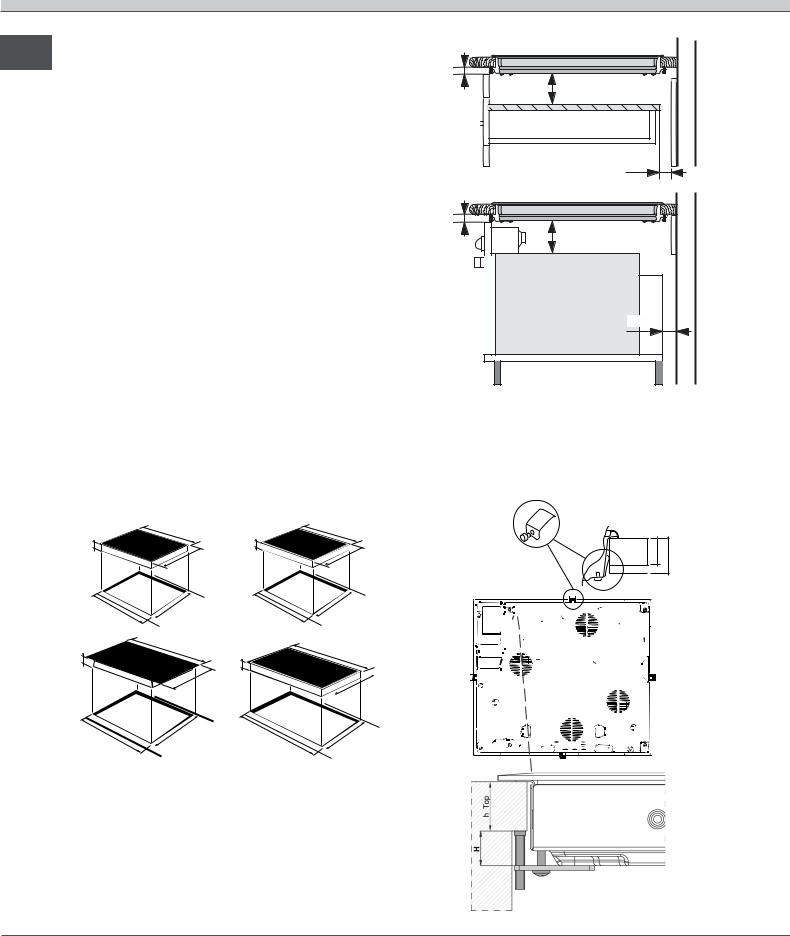
Installation
Conservez ce mode d’emploi pour pouvoir le consulter FR à tout moment. En cas de vente, de cession ou de
déménagement, veillez à ce qu’il suive l’appareil pour informer le nouveau propriétaire sur son fonctionnement et lui fournir les conseils correspondants.
Lisez attentivement les instructions : elles contiennent des conseils importants sur l’installation, l’utilisation et la sécurité de votre appareil.
Positionnement
Les emballages ne sont pas des jouets pour enfants, il faut les mettre au rebut en respectant la réglementation sur le tri sélectif des déchets (voir Précautions et conseils).
L’installation doit être effectuée par un professionnel du secteur conformément aux instructions du fabricant. Une mauvaise installation peut causer des dommages à
des personnes, des animaux ou des biens.
Encastrement
Pour garantir le bon fonctionnement de l’appareil, il faut que le meuble possède des caractéristiques bien précises :
•le matériau du plan d’appui doit pouvoir résister à une température d’environ 100°C;
•si vous souhaitez installer votre table de cuisson audessus d’un four, il faudra que ce dernier soit équipé d’un dispositif de refroidissement par ventilation forcée ;
•évitez d’installer votre table de cuisson au-dessus d’un lave-vaisselle : si c’est le cas, prévoyez une séparation étanche entre les deux appareils ;
•selon la table de cuisson que vous souhaitez installer (voir figures), la découpe du meuble doit avoir les dimensions suivantes :
|
|
|
|
|
590 |
|
|
|
|
|
574 |
|
48 |
|
|
|
|
|
|
|
48 |
|
|
|
504 |
|
|
|
|
|
|
520 |
|
|
|
|
||
|
|
|
|
|
|
|
1 |
|
|
|
|
1 |
|
|
|
|
|
|
- |
|
|
|
|
- |
|
560 |
|
|
|
490 |
+/ |
560 |
|
|
490 |
+/ |
||
+/- |
|
|
|
+/ |
|
|
||||||
|
|
1 |
|
|
|
|
- |
1 |
|
|
||
|
|
|
|
|
690 |
|
|
|
|
|
785 |
|
|
|
|
|
|
|
|
|
|
|
|
|
|
48 |
|
|
|
|
|
|
|
48 |
|
|
|
|
|
|
|
|
|
|
|
520 |
|
|
|
|
|
|
|
|
|
|
|
|
|
|
|
|
|
510 |
|
|
|
|
|
|
|
1 |
|
|
|
|
1 |
|
|
|
|
|
|
|
- |
|
|
|
|
|
560 |
|
|
|
|
|
|
+/ |
750 |
|
|
|
- |
+/- |
|
|
490 |
|
+/ |
|
|
490+/ |
||||
|
1 |
|
|
|
|
|
- |
1 |
|
|
||
|
|
|
|
|
|
|
|
|
|
|
||
Aération
Pour permettre une bonne aération et pour éviter toute surchauffe des surfaces autour de l’appareil, la table de cuisson doit être positionnée :
•à au moins 40 mm de distance du mur arrière et à au moins 600 mm de distance de toute autre surface verticale;
•de manière à ce qu’il reste au moins 20 mm de distance entre la découpe d’encastrement et le meuble en dessous.
min. 20 mm mm5 
 TIROIR
TIROIR
min. 40 mm
min. 20 mm |
5 mm |
CHALEUR |
TOURNANTE |
min. 40 mm |
Fixation
Il est impératif d’assurer l’encastrement de l’appareil sur un plan d’appui parfaitement plat.
Les déformations provoquées par une mauvaise fixation risquent d’altérer les caractéristiques de la table de cuisson ainsi que ses performances.
COTE AVANT
DE LA TABLE DE CUISSON
PLAN DE |
30 |
40 |
TRAVAIL |
TABLE DE CUISSON
RETOURNEE
|
|
|
|
|
|
|
|
|
|
|
|
|
|
|
|
|
|
|
|
|
|
|
|
|
|
|
|
|
|
|
|
|
|
|
|
|
|
|
|
|
|
|
|
|
|
|
|
|
|
|
|
|
|
|
|
|
|
|
|
|
|
|
|
|
|
|
|
|
|
|
|
|
|
|
|
|
|
|
|
|
|
|
|
|
|
|
|
|
|
|
|
|
|
|
|
|
|
|
|
|
|
|
|
|
|
|
|
|
|
|
|
|
|
|
|
|
|
|
|
|
|
|
|
|
|
|
|
|
|
|
|
|
|
|
|
|
|
|
|
|
|
|
|
|
|
|
|
|
|
|
|
|
|
|
|
|
|
|
|
|
|
|
|
|
|
|
|
|
|
|
|
|
|
|
|
|
|
|
|
|
|
|
|
|
|
|
|
|
|
|
|
|
|
|
Plan |
travail |
|
|
|
|
|
|
|||||
h |
di |
|
|
|
|
|
|
|||||
22
